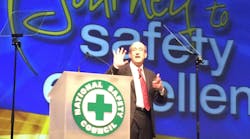NSC 2014: OSHA’s Expanded Notification Requirement Will Create ‘Teachable Moment,’ Michaels Says
When OSHA’s revised severe-injury reporting rule kicks in next year, OSHA Administrator Dr. David Michaels hopes the agency will be able to make inroads with a new set of employers.
“We will, for the first time, have discussions with employers at the moment workers are injured, and we think that’s a teachable moment,” Michaels said during a keynote address at the National Safety Council’s 2014 Congress and Expo in San Diego. “We think that’s a moment to ask the employer, ‘OK, figure out what happened and what you’re going to do to make sure this doesn’t happen.’”
Under the revised rule – which takes effect Jan. 1, 2015 – employers will be required to notify OSHA of work-related in-patient hospitalizations, amputations or losses of an eye within 24 hours. Under the current rule, employers only are required to notify the agency if a worker is killed on the job, or if three or more workers are hospitalized.
During the National Safety Council’s 2014 Congress and Expo in San Diego, Michaels asserted that the current rule doesn’t provide OSHA “the information we need.”
“We’ve had too many instances where we go into a workplace after a referral or a fatality and we’ve discovered that there were two or three serious injuries that same year that we didn’t know about,” Michaels told reporters during an informal press conference after his keynote address. “So now we’re going to be able to get in there after the first [serious injury], and we think that’s a teachable moment.”
Referencing earlier keynote addresses that emphasized the importance of personal responsibility in workplace safety, Michaels noted that “the focus on personal responsibility A) isn’t useful and B) isn’t the law.”
“The law says employers have the responsibility to provide a safe workplace,” Michaels said. “ … What I don’t want to see is the employer telling me [after a serious accident], ‘Well, the guy wasn’t wearing his fall protection,’ or ‘the woman wasn’t wearing her hardhat,’ because blaming it on the worker isn’t going to work. That’s not going to prevent the next one from occurring.”
Regarding how OSHA will be able to leverage its limited resources to reach a new set of employers, Michaels told reporters, “It will be an interesting challenge.”
“It means we have to rethink what we do, but we know that enforcement is only one of our tools,” Michaels said. Noting that federal OSHA inspects 40,000 workplaces each year – out of 7 million business establishments – he added that the agency needs to “find new ways to reach employers and get them to abate hazards.”
While inspections might be warranted in some cases, Michaels said the agency will make an effort to connect employers with resources such as its onsite consultation program and the National Safety Council.
“Rather than inspect all of them, I think it will be much more effective to reach out to them,” Michaels said.
